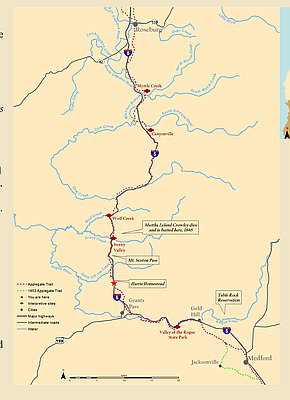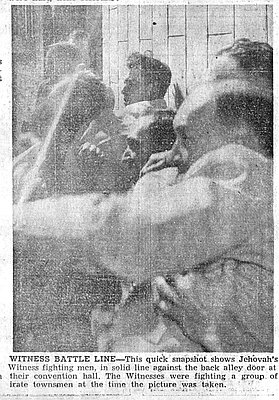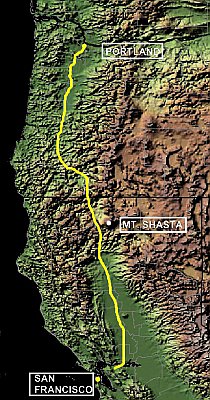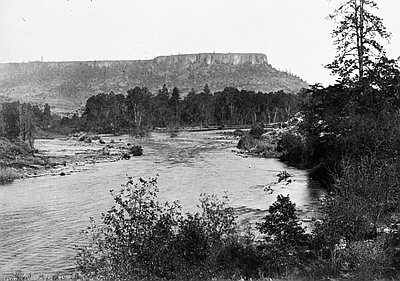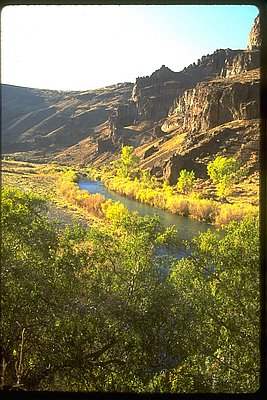Jeff LaLande
Jeff LaLande received a bachelor's degree from Georgetown University in 1969. He has a master’s degree in archaeology from Oregon State University and a Ph.D. in history from the University of Oregon. For over thirty years, he was archaeologist and historian for the Rogue River–Siskiyou National Forest and has been an adjunct faculty member at Southern Oregon University for twenty years. The author of numerous articles and several books, he enjoys learning and writing about Northwest history and is an active board member of several statewide and community organizations.
Author's Entries
-
![Aerial Forest-Fire Patrol Program in Oregon, 1919–1927]()
Aerial Forest-Fire Patrol Program in Oregon, 1919–1927
Beginning in 1919, U.S. Army Air Service pilots, accompanied by U.S. Forest Service observers, patrolled the skies above the forests of western Oregon detecting and reporting fires. Hampered by accidents, reduced funding, and poor communication with firefighters on the ground, the pioneering program did not last. The early effort, however, …
Oregon Encyclopedia
-
![Alexander Ross (1782-1856)]()
Alexander Ross (1782-1856)
Born in the Scottish Highlands, schoolteacher Alexander Ross immigrated to Canada’s St. Lawrence River Valley in 1804. Befriended by fellow Scot Alexander McKay, a veteran Montreal-based fur trader, both men found work in American John Jacob Astor’s boldly conceived Pacific Fur Company enterprise in 1810. The two voyaged around …
Oregon Encyclopedia
-
![Applegate River]()
Applegate River
The approximately sixty-mile-long Applegate River is one of three northward-flowing main tributaries of the Rogue River (the others are the Illinois River to the west and Bear Creek to the east). Although the headwaters of the river's main stem, the Middle Fork, are nearly ten miles into Siskiyou County, California, …
Oregon Encyclopedia
-
![Applegate Trail]()
Applegate Trail
The Applegate Trail, first laid out and used in 1846, was a southern alternative to the western-most segment of the Oregon Trail, with its users leaving the original Oregon City-bound Oregon Trail route near Ft. Hall, in what is now southeastern Idaho, and following the California Trail west …
Oregon Encyclopedia
-
![Ashland]()
Ashland
Ashland, a city of 21,360 people in Jackson County, is situated in the Rogue River/Bear Creek Valley at the foot of the Siskiyou Mountains. The oak-studded foothills of the Cascade Range are clearly visible from the town's main thoroughfares, and Ashland's "Plaza"—the historic core of the downtown area—is …
Oregon Encyclopedia
-
![Bear Creek Valley]()
Bear Creek Valley
Oregon has over ninety separate streams named Bear Creek (far more, in fact, than the Beaver State has Beaver Creeks). Among the most historically notable is the Bear Creek located in central Jackson County, which flows northwesterly between the Siskiyou Mountains on the west and the Cascade Range on the …
Oregon Encyclopedia
-
![Biscuit Fire of 2002]()
Biscuit Fire of 2002
On July 13, 2002, a series of electrical storms passed over southwestern Oregon's Siskiyou Mountains. That afternoon's barrage of lightning strikes ignited five separate fires within the vast Kalmiopsis Wilderness. By early August the fires had grown together into a single, massive, and expanding conflagration that burned well into …
Oregon Encyclopedia
-
![Bonus Army]()
Bonus Army
In 1932, with the Northwest lumber industry hit especially hard by the Depression and with “Hoovervilles” springing up in the city’s Sullivan Gulch and elsewhere, Portland became a center of activity for a direct-action political movement known as the Bonus Army. By late 1931, thousands of unemployed World War I …
Oregon Encyclopedia
-
![Brookings]()
Brookings
Brookings is located at the mouth of the Chetco River, on the southern-most Oregon Coast. Originally situated exclusively on the north bank of the river, the town's suburbs expanded across the river to include the independent community of Harbor. Situated near the former site of a small 1890s-1900s hamlet called …
Oregon Encyclopedia
-
![Butte Falls]()
Butte Falls
Butte Falls, a community of slightly over 400 people, is the smallest incorporated city in Jackson County. Located on the densely forested Big Butte Plateau in the Cascade Range in southern Oregon, the town's name comes from nearby Butte Falls, a ten-foot-high basalt ledge across Big Butte Creek. By the …
Oregon Encyclopedia
-
![Cape Blanco]()
Cape Blanco
Windswept Cape Blanco—situated at N 42˚50'08.12", W 124˚33'51.16"—is the farthest western point on the mainland of Oregon. It is also the second-most westerly point of the contiguous United States (Cape Alava, Washington, exceeds Cape Blanco by some nine minutes of longitude). Located about five miles north of Port Orford and …
Oregon Encyclopedia
-
![Catlow Valley]()
Catlow Valley
Catlow Valley, named for nineteenth-century cattle rancher John Catlow, is a 1,300-square-mile, seemingly level-floored basin in the high-desert country of southern Harney County. A classic graben (a depression formed between uplifted fault blocks), Catlow Valley is bounded by the Hart Mountain fault block (or "horst") to the west, the Steens …
Oregon Encyclopedia
-
![Champagne Riot of 1866]()
Champagne Riot of 1866
The Champagne Riot in Douglas County on December 25, 1866, generated statewide newspaper coverage. The violent episode—named for the Roseburg-area settler at whose home it occurred—was a result of the political, social, and interpersonal fault lines that developed during the Civil War era in the Northwest, particularly in southern …
Oregon Encyclopedia
-
![Chinese mining in Oregon]()
Chinese mining in Oregon
The city of Guangzhou (formerly known to Westerners as Canton) is the capital of Guangdong Province, located along China’s southeastern coast. For many years, it was the only Chinese seaport open to foreigners and was already a bustling international trade center when news of the Sutter’s Mill gold strike near …
Oregon Encyclopedia
-
![Christmas Valley (community)]()
Christmas Valley (community)
The unincorporated town of Christmas Valley (population approximately 1,300) stretches for over five miles along both sides of Lake County Hwy 5-14 (Christmas Valley-Wagontire Road), yet rarely does the community's widely scattered buildings extend more than half a mile back from that road. Located within the flat, sagebrush-filled expanse of …
Oregon Encyclopedia
-
![Columbus Day Storm (1962)]()
Columbus Day Storm (1962)
On the morning of Friday, October 12, 1962—Columbus Day—a massive storm hit the coast of northern California. The storm had originated several days earlier in the Pacific Ocean, about five hundred miles north of Wake Island. Re-energized by a combination of unusual meteorological conditions, the storm moved north with the …
Oregon Encyclopedia
-
![DeAutremont Brothers Train Hold-up at Tunnel 13]()
DeAutremont Brothers Train Hold-up at Tunnel 13
The most famous train holdup in Oregon was a ham-fisted disaster. On October 11, 1923, an attempt by brothers Ray, Roy, and Hugh DeAutremont to rob a Southern Pacific Railroad train at Tunnel 13, high in Oregon’s Siskiyou Mountains, ended with a burned-out mail car, no payout, and four men …
Oregon Encyclopedia
-
![Earl Wilcox Snell (1895–1947)]()
Earl Wilcox Snell (1895–1947)
Earl Snell was a Republican governor of Oregon who served during World War II and into the early postwar years. During his tenure, the state faced socio-economic change on the home front and began its adjustment to what became a booming economy based on agriculture and timber. Snell’s death in …
Oregon Encyclopedia
-
![Forest Fires of 1910]()
Forest Fires of 1910
During the late summer of 1910, a searing drought combined with high-velocity August windstorms to create a fiery holocaust in the forests of the Pacific Northwest. The fires also laid a major challenge at the feet of the newly established U.S. Forest Service, which was charged with fighting the fires. …
Oregon Encyclopedia
-
![Fort Umpqua (HBC fort, 1836-1853)]()
Fort Umpqua (HBC fort, 1836-1853)
Fort Umpqua was a small but important post in the Hudson’s Bay Company’s fur-trade empire in the Oregon Country. The farthest south of the company’s posts, the fort was located on the Umpqua River in present-day Douglas County. Operating between 1836 and the early 1850s, it was crucial to …
Oregon Encyclopedia
-
![Gilbert Gable (1886-1941)]()
Gilbert Gable (1886-1941)
Although Gilbert Gable lived in Oregon for only a few years, he gained notoriety in the state, both as mayor of Port Orford and as the originator and main promoter of the 1941 secession of the State of Jefferson from Oregon and California. Born in Shamolkin, Pennsylvania, in 1886, Gable …
Oregon Encyclopedia
-
![Good Government Congress (Jackson County Rebellion)]()
Good Government Congress (Jackson County Rebellion)
During the severe economic stress of the early 1930s, a homegrown, radical, "populist" political movement that called itself the Good Government Congress briefly took over the reins of Jackson County's government. The GGC, which proved strongest in rural areas and among Medford’s working-class residents, was founded, promoted, and led …
Oregon Encyclopedia
-
![Guy Cordon (1890-1969)]()
Guy Cordon (1890-1969)
Guy Cordon, a self-effacing Republican tax attorney from Roseburg, long guided the economic fortunes of western Oregon as founder and head of the Association of O&C; Counties. His diligence and effectiveness as a lobbyist helped reward the counties with a half-century-long bounty of federal dollars from harvesting timber on …
Oregon Encyclopedia
-
Harry & David/Bear Creek Orchards
Harry & David, the marketing brand for Medford's Bear Creek Corporation and its many enterprises, is perhaps the most widely known commercial name associated with Medford and the Rogue River Valley. Building on the tradition of giving gift boxes of fruit on Christmas and other holidays, Harry & David's …
Oregon Encyclopedia
-
![Harry Dolan Boivin (1904–1999)]()
Harry Dolan Boivin (1904–1999)
Harry Boivin, a legislator from Klamath County, rose to prominence during the late 1930s when, at age thirty-three, he became the youngest Speaker of the Oregon House of Representatives. Known as an effective negotiator and canny strategist, Boivin earned the nickname “The Fox” early in his career. That sobriquet stayed …
Oregon Encyclopedia
-
![High Desert]()
High Desert
Oregon’s High Desert is a place apart, an inescapable reality of physical geography. The region forms an extensive area that is substantially different in climate, elevation, and hydrology from any other part of Oregon, and it has a distinctive human history. Geography The geographic definition of the High Desert is …
Oregon Encyclopedia
-
![James Douglas McKay (1893-1959)]()
James Douglas McKay (1893-1959)
Douglas McKay, a conservative Republican, was governor of Oregon from 1949 through 1952 and U.S. Secretary of the Interior from 1953 to 1956. An affable and able politician, he won every election, from his first campaign for Salem city councilor in 1930 through his re-election as governor in 1950. That …
Oregon Encyclopedia
-
![Jefferson Public Radio]()
Jefferson Public Radio
Owned by and operating from the campus of Southern Oregon University in Ashland, Jefferson Public Radio (JPR) serves one of the largest geographic areas of any public radio station in the United States (over 70,000 square miles). It broadcasts with a system of transmitters and translators extending from central …
Oregon Encyclopedia
-
![Jehovah's Witnesses Riots, 1942]()
Jehovah's Witnesses Riots, 1942
On Sunday, September 20, 1942, nearly a thousand residents of Klamath Falls clashed with a group of Jehovah’s Witnesses attending their state convention in a large garage at Ninth and KIamath Streets. The Klamath Falls Herald and News described what it called the Klamath Falls Jehovah’s Witness Riot as “an …
Oregon Encyclopedia
-
![John B. Waldo (1844-1907)]()
John B. Waldo (1844-1907)
John Breckenridge Waldo was the first Oregon Supreme Court chief justice born in the state. He may be best known as an outdoorsman and proponent of forest conservation for the Cascade Range.Waldo was the third son of Virginians Daniel and Malinda Waldo. The Waldos had joined the "Great …
Oregon Encyclopedia
-
John Colter (ca. 1775-1813)
John Colter was a member of the Corps of Discovery, commanded by Meriwether Lewis and William Clark. He was among the majority of the party that, while huddled at stormy Station Camp on the north bank of the Columbia in late 1805, voted for crossing the Columbia to winter on …
Oregon Encyclopedia
-
![Joseph Schafer (1867-1941)]()
Joseph Schafer (1867-1941)
Joseph Schafer was Oregon's first academically trained, professional historian, serving on the faculty of the University of Oregon for twenty years. While in Eugene, he wrote what became a classic textbook on Pacific Northwest history. A student of Frederick Jackson Turner’s at the University of Wisconsin, Schafer remained a …
Oregon Encyclopedia
-
![Lakeview]()
Lakeview
The City of Lakeview, in northern Goose Lake Valley at an elevation of 4,804 feet, calls itself Oregon’s Tallest Town. By far the largest community in Lake County, it serves as the county seat and provides basic services, from medical facilities to ranching and equipment sales, for residents of southeast …
Oregon Encyclopedia
-
![Mount Ashland]()
Mount Ashland
At 7,532 feet, Mount Ashland is the tallest mountain in Oregon west of the Cascade Range's chain of volcanic peaks. Located about six miles west of Siskiyou Pass, the mountain appears from the south simply as a higher point along the Siskiyou Crest, the major east-west ridge system of …
Oregon Encyclopedia
-
![Mount McLoughlin]()
Mount McLoughlin
Mount McLoughlin, at 9,495 feet, is the lowest in Oregon's chain of six major Cascade Range volcanic peaks (the others are Mount Hood, Mount Jefferson, and the Three Sisters, all above 10,000 feet). Viewed from the northwest, Mount McLoughlin's symmetrical shape is the dominant landmark of the Rogue River …
Oregon Encyclopedia
-
![Mt. Ashland Ski Area]()
Mt. Ashland Ski Area
The Mt. Ashland Ski Area, which encompasses over 240 acres of national forestland, is situated on and near the summit of Oregon’s highest peak west of the Cascade Range. Started largely by local ski enthusiasts, the ski area has been an important community asset since the early 1960s. With …
Oregon Encyclopedia
-
![Oregon–to–California Trail (1820s–1860s)]()
Oregon–to–California Trail (1820s–1860s)
The north-south Oregon–to–California Trail was the main overland route for travel and shipment of goods between the two states during the nineteenth century. The trail, which began as a rough trappers’ route, became a crucial overland link that eventually established the course of a north-south rail line and a modern …
Oregon Encyclopedia
-
![Peter Skene Ogden (1790-1854)]()
Peter Skene Ogden (1790-1854)
More than any other figure during the years of the Pacific Northwest's beaver trade, Peter Skene Ogden epitomized that endeavor's transcontinental reach, its rapacious competition for wealth, and its relentless challenge to the stamina and skill of those in charge of trapping brigades. Ogden remained a central player throughout the …
Oregon Encyclopedia
-
![Pilot Rock (geologic feature)]()
Pilot Rock (geologic feature)
Located east of Siskiyou Pass inside the Cascade-Siskiyou National Monument, Pilot Rock is a prominent landmark in southwestern Oregon, protruding from the skyline of the Rogue-Klamath watershed divide like a hitchhiker’s thumb. The Upland Takelma people, who could see the rock rising above the horizon from their homeland on …
Oregon Encyclopedia
-
![Port Orford Meteorite Hoax]()
Port Orford Meteorite Hoax
The Port Orford Meteorite has captured the imagination of Oregonians for well over a century. Although the meteorite remains an object of speculation, the scientific consensus is that the “find” was a hoax. Nevertheless, the persistence of the meteorite story has become a part of Oregon history. In 1856, the …
Oregon Encyclopedia
-
Prehistoric Gardens
Prehistoric Gardens, with its twenty-foot-tall concrete Tyrannosaurus greeting travelers a few miles south of Port Orford on Highway 101, has been a successful commercial roadside attraction for over six decades. Along a winding path through a dense forest of spruce and sword ferns, twenty-three life-size sculptures of dinosaurs and other …
Oregon Encyclopedia
-
![Richard L. Wendt (1931-2010)]()
Richard L. Wendt (1931-2010)
Richard L. Wendt, of Klamath Falls, was a founder of JELD-WEN, Inc., one of Oregon’s biggest companies. By the 1990s, the company was the largest maker of windows and doors in the world. Wendt, a publicity-shy individual who continued to live in the same modest ranch-style home after accumulating a …
Oregon Encyclopedia
-
![Robert Ruhl (1880-1967)]()
Robert Ruhl (1880-1967)
Robert Ruhl, publisher and editor of the Medford Mail Tribune, was Oregon's archetypal crusading small-town newspaperman. His editorial battle against the Ku Klux Klan in the 1920s earned him the respect of other Oregon journalists, and his paper's fight against a radical local "populist" movement brought him the Pulitzer …
Oregon Encyclopedia
-
![Rogue River]()
Rogue River
The Rogue River, Oregon’s third-longest river (after the Columbia and Willamette), flows through the southwestern part of the state for 215 miles. Descending from its source high in the Cascade Range, the Rogue reaches the Pacific at the City of Gold Beach. The river’s watershed occupies 5,164 square …
Oregon Encyclopedia
-
![Rogue River National Forest]()
Rogue River National Forest
For over a century, the Rogue River National Forest has filled an important role in the economic development, watershed management, and recreational uses of southwestern Oregon. The forest, which in 2003 consisted of about 632,000 acres, embraces most of the higher-elevation lands of the upper Rogue River watershed. The land …
Oregon Encyclopedia
-
![Roseburg Blast]()
Roseburg Blast
In the early morning hours of August 7, 1959, a parked truck—loaded with two tons of dynamite and over four tons of ammonium nitrate—caught fire outside a supply store on the edge of downtown Roseburg. The resulting explosion, known locally as The Blast, sent a ball of flame and …
Oregon Encyclopedia
-
![Siskiyou Mountains in Oregon]()
Siskiyou Mountains in Oregon
Southwestern Oregon’s Siskiyou Mountains, which comprise the largest subrange of the Klamath Mountains, are distinctive in their geology, biology, and history. The rugged terrain includes some of the oldest rocks in Oregon, and the mountains support by far the most diverse flora in the state. As a subrange of the …
Oregon Encyclopedia
-
![Siskiyou Pass]()
Siskiyou Pass
Siskiyou Pass, including the 4,310-foot-high Siskiyou Summit of Interstate-5 that is located a short distance east of the original historic pass, is the highest and most historically significant mountain crossing on the main transportation route that links California and Oregon. The geographic feature known as Siskiyou Pass/Siskiyou Summit has earned …
Oregon Encyclopedia
-
![State of Jefferson]()
State of Jefferson
In all of American history, only two states have been formed from older states that were already admitted to the Union: Maine (from Massachusetts, in 1820) and West Virginia, during the Civil War. However, in 1941, some residents of northern-most California and southwestern Oregon—where people had long been resentful …
Oregon Encyclopedia
-
![Steens Mountain]()
Steens Mountain
Rising to an elevation of 9,733 feet, Steens Mountain is the highest point in southeastern Oregon. It looms like a massive basalt island, with its summit over 5,000 feet above the Alvord Desert to the east. Because of its variety of elevation zones and its topographical diversity—the result of heavy …
Oregon Encyclopedia
-
![Table Rock Treaty of 1853]()
Table Rock Treaty of 1853
The Council of Table Rock brought a temporary peace between Indigenous residents of the Rogue River Valley and the American settlers that had swarmed into the region after 1850. The site of the Council’s negotiations was on the north side of the Rogue River, near the southwestern base of …
Oregon Encyclopedia
-
![Table Rocks]()
Table Rocks
The Table Rocks, two large mesas north of Medford, rise nearly 800 feet from the north side of the Rogue River, opposite where Little Butte Creek and Bear Creek join the river from the south. Lower Table Rock is the downstream, westernmost mesa, while Upper Table Rock is …
Oregon Encyclopedia
-
![Two-Bits, the World War II Lookout Dog]()
Two-Bits, the World War II Lookout Dog
A persistent fox terrier named Two-Bits earned a brief measure of national fame while spending the winter of 1942-1943 at the Siskiyou Mountains' isolated Whisky Peak Lookout. Called a "war hero" by the press, Two-Bits became the subject of front-page newspaper articles across the country, and his story was told …
Oregon Encyclopedia
-
![U.S. Bureau of Land Management]()
U.S. Bureau of Land Management
The Bureau of Land Management (BLM) administers over 15.7 million acres of public land in Oregon, equal to about twenty-five percent of the state's total acreage. About 13.5 million acres in the state are in the public domain, while about 2 million acres are the densely forested O&C; Lands of …
Oregon Encyclopedia
-
![U.S. Bureau of Reclamation]()
U.S. Bureau of Reclamation
The U.S. Bureau of Reclamation, in the Department of the Interior, has been an important force in Oregon since soon after the agency's founding with the 1902 Reclamation (Newlands) Act. Twenty-nine Reclamation dams, most of them in the arid parts of the state, have impounded reservoirs for irrigation purposes—some of …
Oregon Encyclopedia
-
![Union Peak and Union Creek]()
Union Peak and Union Creek
Union Peak, rising to an elevation of 7,709 feet, dominates the southwest corner of Crater Lake National Park. It is situated about six miles from the nearest portion of Mount Mazama's caldera, which holds Crater Lake. From places within the Rogue River Valley, Union Peak's unmistakable steep-sided, pyramid profile …
Oregon Encyclopedia
-
![William Green T'Vault (1809-1869)]()
William Green T'Vault (1809-1869)
William Green T’Vault had a wide-ranging career in early Oregon. A truculent and controversial political figure during the territorial and Civil War periods, T'Vault (pronounced "Tee-vault") was a slavery-and-secession advocate who became a prominent, strident voice for the minority of Oregonians who agreed with him. T’Vault was born in 1809, …
Oregon Encyclopedia
-
![Zane Grey (1872–1939)]()
Zane Grey (1872–1939)
Inveterate angler Zane Grey, writer of highly popular Western fiction, first visited Oregon in 1919 to fish the waters of the Rogue River and Crater Lake. He returned to the Rogue throughout the 1920s, turning his 1925 drift-boat expedition down the length of the lower Rogue into a chapter of …
Oregon Encyclopedia





